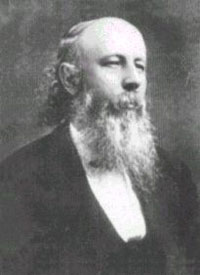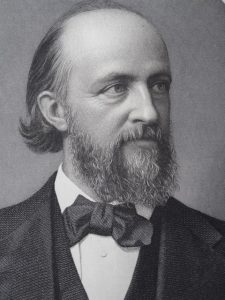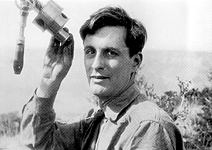 Carroll Dunham M. D. (29 October 1828 – 18 February 1877) was an influential American homeopathic physician who was Dean of Faculty at the New York Homeopathic Medical College and also served as President of the American Institute of Homeopathy
Carroll Dunham M. D. (29 October 1828 – 18 February 1877) was an influential American homeopathic physician who was Dean of Faculty at the New York Homeopathic Medical College and also served as President of the American Institute of Homeopathy
Dunham traveled to Europe on several occasions to study homeopathy at its source and spent time observing homeopathic practitioners in Dublin, Paris and Vienna.
Carroll Dunham was a cousin of Clemence Lozier. Homeopaths Harriette Charlotte Keatinge, Anna Manning Comfort, Emily L. Manning Smith, Jennie Van Holland Baker, Emily L. Smith and Charlotte Harned Woolley were all relatives. Clemence Lozier’s daughter in law, Charlotte Denman Lozier, was also a homeopath as was her brother, William Harned.
Dunham was one of the leading figures in the creation of the quinquennial international homeopathic conventions that began in Philadelphia in 1876. Dunham was president and organizer of that first congress.
Carroll Dunham was born 29 October 1828, in New York City. He was the youngest of four sons of Edward Wood Dunham and Maria Smyth Parker. Both parents were from old, prominent families of New Brunswick, New Jersey.
Dunham graduated from Columbia University with Honours in 1847. In 1850 he received his M.D. degree at the College of Physicians and Surgeons of New York.
Almost immediately after graduation the new Dr. Dunham traveled to Philadelphia to meet Dr. Constantine Hering, one of the most learned homeopathic physicians in the world. Dunham not only gained valuable teaching experience and indispensable advice, he said: “I gained the most helpful, generous, and genial friend I have ever made.”
After completing his studies with Hering, in 1850 Dunham went to Europe to expand his medical knowledge and in particular to study homeopathy. He visited Dublin, where he served a term in the lying-in hospital. While in Dublin, he received a dissecting wound that nearly killed him, but with the aid of homoeopathy he cured himself with Lachesis.
Dunham spent several months in Paris and Vienna observing the different kinds of treatment in hospitals and private practice. In Paris he studied under Bouillard, Velpeau, Armand Trousseau, Ricord, Simon, Heurteloup, among others, all the while visiting the Homeopathic Hospital headed by Jean Paul Tessier Senior.
Continuing his educational sojourn, Dunham went briefly to Berlin and then on to Vienna where he attended hospital clinics of Franz Wurmb and the lectures of Kaspar on Materia Medica.
Dunham also visited Münster and became a pupil of the veteran homeopath Boenninghausen, daily attending his office and making careful and elaborate notes of the cases that he saw, their treatment and the results.
Having thus profitably spent a year in the diligent prosecution of his mission, he returned home fully persuaded of the truth of the great therapeutic principle propounded by Hahnemann, and an ardent disciple and admirer of that master.
On his return from Europe in 1852 Dunham began practice in Brooklyn. His success there was so great that Dr. Phineas Parkhurst Wells, who had been the Dunham family physician for many years, said, “He was always my friend, never my pupil.”
In February, 1854, Dunham married Harriet E. Kellogg (1828 – 1878), daughter of homeopath Edward Kellogg and his wife Esther F. Kellogg. In 1858 they moved to Newburgh, and in 1863 to Irvington-on-Hudson, New York, where they had six children: Carroll, Edward Kellogg, Theodore, Herbert, Constantine, and Beatrice. Dunham resided there until his death, while maintaining an office and a consulting practice in New York City.
In 1855 – 56, Dunham returned to Europe again for health reasons. He spent several weeks in Münster with Boenninghausen, renewing his studies there. He traveled to Italy for the winter where he learned Italian and brushed up on anatomy.
However, in 1863 or 64 he became ill again. He developed cardiac rheumatism and leading allopathic specialists warned he did not have long to live. Dunham consulted Hering who, after meticulous examination of the symptoms prescribed the single remedy, Lithium carb, which promptly cured him.
Dunham was editor of the “American Homeopathic Review” from 1861-66. In 1865, he was made Professor of Materia Medica at New York Homeopathic Medical College and later became its Dean, reorganizing it and establishing it permanently and prosperously.
He was an original incorporator of the New York State Homeopathic Asylum for the Insane, the first institution of its kind in the world. Dunham also served as President of the New York County Homeopathic Medical Society.
Dunham was renowned for his diplomacy, and this was perhaps nowhere more clearly demonstrated than in a presentation he made before the AIH in 1870 titled “Freedom of Medical Opinion and Action: a Vital Necessity and a Great Responsibility.” Despite his devotion to strict Hahnemannian homeopathy, Dunham argued that homeopaths must remember their own struggle for liberty against restrictive practices which interfered with free thought and expression.
To be a homeopath, he said, required adherence to a fundamental therapeutic law, but there could be disagreement about its detailed interpretation. He himself was a purist, a rigid Hahnemannian; nevertheless he had to acknowledge the existence of self-styled homeopaths who thought otherwise, and the right way to deal with them, he believed, was not to proscribe them but to encourage free and open discussion.
Unfortunately, the reaction to Dunham’s talk was precisely the opposite to what he had hoped. American homeopathy fragmented further, the conservative, pure Hahnemannians separated into the International Hahnemannian Association in 1881, alarmed at the tolerance shown towards hybrid-homeopaths. The confusion that arose from this debate and the disagreements between competing low and high potency proponents cumulatively undermined homeopathy in the public mind.
INTERNATIONAL HOMEOPATHY
In 1867, at its twentieth meeting in New York City, the American Institute of Homeopathy acted on a proposal made by Tullio Suzzara Verdi to create an international homeopathic congress. To that end a special corresponding committee was formed, that included Dunham, Verdi, Israel Tisdale Talbot M.D. of Boston, and Ernst Bruno De Gersdorff M.D. of Salem. Verdi was to write to the French and Italian associations and physicians; De Gersdorff was to correspond with the German ones and Israel Tisdale Talbot and Dunham were to address those in Great Britain, Spain, South America, Australia, and the West Indies.
At the Twenty-Fifth AIH meeting held in Washington, D.C., in May 1872, Dunham reviewed the improved organization of homeopathy in several countries following the circular letter of 1867, reporting on the establishment of new national associations in Italy and Switzerland and revived associations in Britain, France, and Germany.
Dunham’s health failed him again and in 1874 he left for Europe again, this time accompanied by his family. While in Europe, he courted the European homeopaths on behalf of the concept of the World’s Congress, the first of which the AIH had resolved to hold in Philadelphia in June, 1876.
In 1875, he returned to the U.S.A. finding himself so unexpectedly improved in his health, strength, and spirits that he took up his previous occupations. That year, he was elected President of the American Institute of Homeopathy for 1876 so as to be so in the year of the World’s Congress.
Dunham was instrumental in the organization and running of the 1876 World’s Congress, translating, abridging, correcting, proofing hundreds of pages of correspondence and papers into the published Transactions. In addition, he managed the general arrangements of the convention in Philadelphia.
He wrote at the time: “Of course, I have convention on the brain. I eat, sleep and live it; and have put some of my best blood into it; but hope to have some left, when all is over.”
Dunham was exhausted from his efforts, and after briefly recuperating contracted diphtheria. His strength, never recovered, waxed and waned, until he took to his bed for the last time on December 2, 1876. He was cared for by his family and by Dr. P. P. Wells and Dr. Benjamin F. Joslin until February 18, 1877, when he died in his sleep, aged just 49. Both physicians laid his demise at the feet of no disease but the exhaustion produced by the excessive labors related to the World’s Congress.
Dunham’s most lasting legacy lay in the success of the 1876 World’s Congress. This resulted in a series of subsequent meetings held every five years. It also laid the foundation for the creation in 1925 of the LIGA International Homeopathic Medical League.
Select Publications:
Although Dunham never wrote a book, his writings were voluminous. Soon after his death some of his best writings were collected by his wife and published as:
Homoeopathy: The Science of Therapeutics (1877)
The following year saw a posthumous publication of the notebooks Dunham used to give his lectures:
Lectures on Materia Medica (1878)
Of interest:
Theodore Dunham Junior (1897 – 1984), Scientific Director of the New York Fund for Astrophysical Research from its founding in 1936 until his death in 1984, was the grandson of Carroll Dunham.  Astronomer Cecilia Payne Gaposchkin, the great grand daughter of homeopath James John Garth Wilkinson, had an unexpected meeting with Theodore Dunham Jr. when he was sixteen years old.
Astronomer Cecilia Payne Gaposchkin, the great grand daughter of homeopath James John Garth Wilkinson, had an unexpected meeting with Theodore Dunham Jr. when he was sixteen years old.
The Dunham Family Papers are held in the Sophia Smith Collection of Women’s History at Smith College. A biographical history of the family is available at the Smith College Library:
Herbert and Constantine both died before one year. Harriet’s sister, Amelia Nash (Kellogg) Henshaw–affectionately called “Aunt Rabbit,” studied under artist Samuel Colman (Anne Lawrence Dunham’s husband).
Beatrice Dunham was a prolific writer of stories and verses. She and other family members also compiled a family magazine called “The Phoenix.”
Edward Kellogg Dunham M.D. (1860 – 1922) was well known for his work in the fields of pathology and bacteriology. He earned his medical degree from Harvard Medical School in 1886 then studied for a period at Robert Koch‘s laboratory in Berlin where he discovered the “cholera-red” reaction. After returning to the United States, he worked for the Board of Health Commission in Boston and later became professor of pathology at the Bellevue Medical College of New York University.
During World War I, he worked in U.S. Army hospitals, researching and treating meningitis cases. Soon he became involved in treating soldiers infected with empyema (a lung disease related to pneumonia) and in 1918 was appointed chairman of the “Empyema Commission.”
After Edward’s death his empyema research was published by his wife, Mary (Dows) Dunham, and several of his colleagues. In 1923 Mary gave an endowment to Harvard Medical School for the establishment of the “Edward Kellogg Dunham Lectures for the Promotion of the Medical Sciences.”
In 1893 Edward married Mary Dows (1865 – 1936), daughter of David Dows (1814 – 1890) and Margaret (Worcester) Dows (1831 – 1909), also of Irvington, N.Y. David Dows headed the New York firm, David Dows and Company, one of the largest grain dealers in the country. He also served on the Board of Directors of Chicago, Rock Island and Pacific Railway Co.
Mary was stricken with polio as a child and was left partially disabled. She suffered from almost constant pain throughout her life, nevertheless, traveled extensively and pursued various artistic and philanthropic activities. Mary became interested in photography at a young age and was encouraged in her endeavors by artist Samuel Colman (Anne Lawrence Dunham’s husband). She traveled to the western United States and Europe numerous times before her marriage to Edward in 1893.
Mary and Edward traveled together in Europe, Egypt, and the Western U.S. from the 1890s to the 1910s. In Egypt, they journeyed down the Nile River on a houseboat for three weeks in 1906. Edward and Mary had two children: Theodora Dunham (1895 – 1983) and Edward Kellogg Dunham, Jr. (1901 – 1951).
Soon after the birth of their daughter Theodora, Edward and Mary moved from Litchfield, Connecticut, to New York City. In 1898 they built a house in Seal Harbor, Maine, which they named “Keewaydin.” The Dows family had spent many summers in Seal Harbor and several of Mary’s siblings also made it their summer home.
During World War I, Mary and Theodora were involved with the American Fund for French Wounded (AFFW), an organization which provided medical and material aid to wounded soldiers and refugees. Theodora went to France to work as a volunteer at the front from 1916 to 1917. Mary organized volunteers in both New York City and in Seal Harbor to send relief packages overseas for the AFFW workers there to distribute to refugees and soldiers.
During the early twentieth century, Mary and Edward were involved in various philanthropic activities in New York and Seal Harbor. They worked with the New York Cooking School and several New York City hospitals to establish a cooking school for nurses with the aim of improving hospital food service.
In Seal Harbor, Edward tested the milk of the local dairy farms, and Edward and Mary helped to organize the Mount Desert Chapter of the American Red Cross for which both Mary and Edward Dunham, Jr., were board members. The family was also active in the Seal Harbor Village Improvement Society.
Edward Kellogg Dunham, Jr. (1901 – 1951), was graduated from Harvard University in 1922, and worked as assistant manager for the Corn Exchange Bank (his great-grandfather’s institution) in New York through the 1920s.
After that, much of his time was occupied with other financial activities as treasurer of Dows Estates (established with the estate of his grandparents) and as trustee of his mother’s estate. Edward lived for a few years in the western United States where, in 1933, he met and married Anne (“Nancy”) Yellott. Edward and Nancy had two children: Edward Kellogg Dunham III and Elizabeth Dunham.
They eventually moved to New York City and spent their summers in Seal Harbor where Edward continued in his parents’ philanthropic footsteps.


happy to save this page for my detailed study of my favourite homeopath,thank you a lot for this information.i will surely be in contact with you in future,kindly enlighten me about other activities pertaining to homeopathy and homeopathic philosophy.
Thank you for this information. I am researching the Dunham family to discover the history of a mansion located at 30 South Broadway, Irvington, NY which I believe was built by Carroll Dunham Junior in 1888-1890. Do you happen to know where Carroll Dunham Senior lived in Irvington when he moved there from Newburgh, NY in 1863?
There is a development application in progress which would demolish the mansion and I am attempting to reveal its historical and cultural significance in an attempt to save it. Dunham Senior’s brothers lived in what is now Matthiessen Park (Irvington) but I cannot determine where Dunham Senior lived. Thank you in advance- Mary Beth Dooley
This has been most interesting. I am interested in any information about early practice of homeopathic veterinary medicine